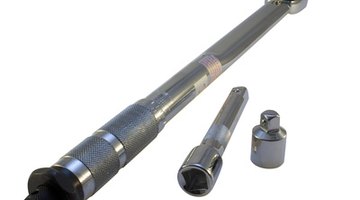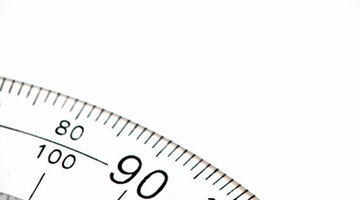Definition of a Torque Angle
The term “torque angle” is not very commonly used, even among experts in industrial measurements, yet the torque-angle method of analysis is simple, highly accurate and straightforward, greatly reducing the margin of error in the measurement of force needed to secure bolts and fasteners of varying sizes and lengths.

Torque as a Measurement of Force
A concept commonly applied in physics and mechanical engineering, torque is a measurement of force that specifically relates to the amount of strength required to rotate any given object. We generally think of a force as a push or a pull, but torque is a twisting or turning force that moves objects such as bolts or flywheels. The International System of Units for torque is the Newton meter (N.m), and the torque wrench is the tool used to apply the required force to a fastener.
Angle as a Mathematical Term

An angle is the shape formed by two lines that share the same end point. If you placed a dot on a page and then marked two lines that ended up in different places, you would create an angle. There are various ways of measuring angles. The most common is by using the gradient, or height of the slope. The gradient is equal to the tangent of the angle and is often expressed as a percentage. We commonly use gradient to calculate the grade of a hill on a road. A right angle has a gradient of 90 percent.
The Torque Angle
To validate exactly how much torque has been applied to a fastener, hand torque audits are carried out. They can verify the tension required and determine that the fastener has been correctly tightened. Occasionally when some fasteners are measured, they reveal a relatively high level of torque, yet when the clamp force (tension) is measured the two recordings do not coincide; the fasteners actually required a much lower amount of clamp force to be accurately tightened. To reduce the disparity between these two tests, a measurement technique called a torque angle was created.
Measuring the Torque Angle
The twisting force is tested and plotted on a graph as the fastener is installed and uninstalled. The subsequent curve that is created by these graph coordinates is the torque angle. This results in an easier, more visual and accurate way of recording the required force and the accurate torque wrench needed to secure the fastener.
The Drip Cap
- The term “torque angle” is not very commonly used, even among experts in industrial measurements, yet the torque-angle method of analysis is simple, highly accurate and straightforward, greatly reducing the margin of error in the measurement of force needed to secure bolts and fasteners of varying sizes and lengths.
- The International System of Units for torque is the Newton meter (N.m), and the torque wrench is the tool used to apply the required force to a fastener.
- There are various ways of measuring angles.
- They can verify the tension required and determine that the fastener has been correctly tightened.
References
Resources
Writer Bio
Based in the United Kingdom, Christina Comben has been producing high-quality content for corporate websites, marketing materials, consumer articles and travel stories since 2002. She holds a Bachelor of Arts in communications and marketing from London Guildhall University and a Master of Business Administration from Palermo University, Buenos Aires, Argentina.
Photo Credits
- torque wrench and accessories image by Christopher Dodge from Fotolia.com
- torque wrench and accessories image by Christopher Dodge from Fotolia.com
- Protractor Background image by Janet Wall from Fotolia.com
More Articles



